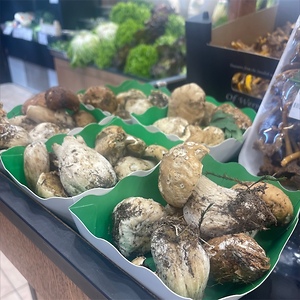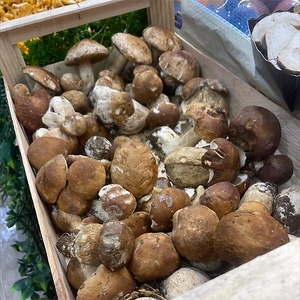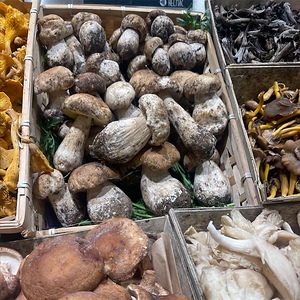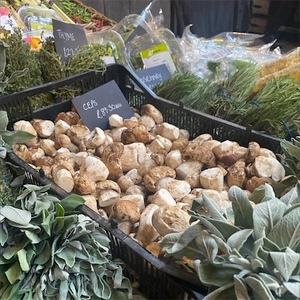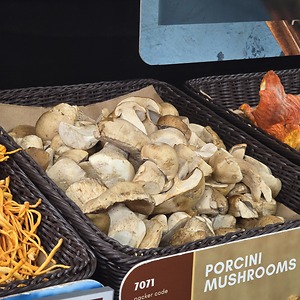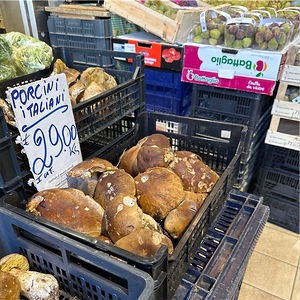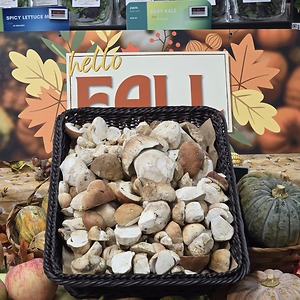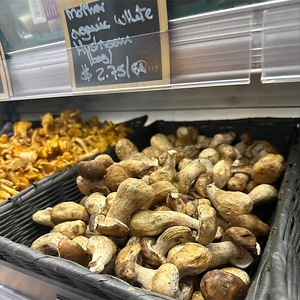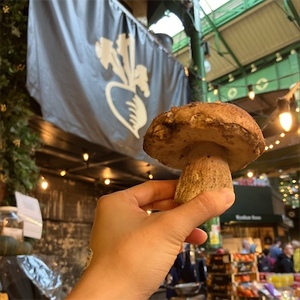


Porcini Mushrooms
Estimated Inventory, lb : 0
This item was last sold on : 07/09/25
Description/Taste
Porcini mushrooms vary in size depending on their maturity at harvest, but generally average 7 to 30 centimeters in diameter. It is common for Porcini mushrooms to be collected when they are younger and smaller in size, but if left to grow, some mushrooms can reach over one kilogram in weight. The mushrooms are comprised of a domed cap and a thick, bulbous stem. The caps are smooth and taut with a slightly greasy, viscous feel. It is important to note that Porcini mushrooms will vary in cap color, as debris and fallen leaves can leave a residual coloring on the fungi’s surface. Porcini mushroom caps are typically brown to red-brown, and the margins showcase a lighter hue. When the cap is sliced in half, the flesh remains white and does not discolor. Porcini caps will flatten out over time. Underneath the cap, the mushroom bears ivory to yellow, spongy tubes that release green-brown spores. This is a distinguishing characteristic, as other mushroom species have gills, not pores. The fleshy white stems range 8 to 25 centimeters in length and are broad, firm, and solid. The stems also feature a reticulated pattern on their exterior, giving the surface a webbed appearance. The highest-grade Porcini mushrooms will be firm and compact, while other types will be softer and spongier. Once cooked, the flesh softens and becomes tender and slightly chewy. Porcini mushrooms are edible raw or cooked and have a rich, nutty, and earthy flavor.
Seasons/Availability
Porcini mushrooms are generally available in the fall and winter. They may also appear for a shorter season in late spring.
Current Facts
Porcini mushrooms, botanically a part of the Boletus genus, are a category of culinary mushrooms belonging to the Boletaceae family. Scientists estimate over sixty Boletus species may be collectively grouped under the Porcini name, naturally growing worldwide, and the most well-known species in commercial markets is Boletus edulis. Porcini mushrooms are a type of mycorrhizal fungi, meaning they form a mutual symbiotic relationship with living tree roots. The mushroom uses sugars from the roots to grow, while the tree roots absorb water and nutrients from the mushroom. This delicate balance keeps the Porcini mushroom from being extensively cultivated, as it cannot easily be recreated. Most Porcini mushrooms are foraged from wild populations, and the fungi are a treasured and anticipated seasonal culinary ingredient. Porcini mushrooms are known by several regional names worldwide, including King Bolete, Cep, and Cèpe de Bordeaux in France, Penny Bun in England, Porcino and Porcini in Italy, Steinpilz in Germany, Panza in Mexico, Belyy Grib or Borovik in Russian, and Mei Wei Niue Gan Jun in Chinese. Porcini mushrooms are found in commercial markets in fresh and dried form, and chefs savor the fungi for their nutty taste, dense, meaty texture, and versatility.
Nutritional Value
Porcini mushrooms are a source of vitamins A, B, C, and D to maintain healthy organs, contribute to energy production in the body, strengthen the immune system, and aid in calcium absorption. Porcini mushrooms also provide fiber to improve digestion and minerals like iron, zinc, calcium, phosphorus, potassium, and magnesium. Iron helps the body produce hemoglobin for oxygen transport through the bloodstream, zinc aids cell and tissue development, and calcium and phosphorus support bone health. Potassium balances fluid levels within the body, and magnesium assists in controlling daily nerve functions. Porcini mushrooms also have antioxidant and anti-inflammatory properties.
Applications
Porcini mushrooms have a sweet, nutty, and earthy flavor suited for fresh and cooked culinary preparations. Young Porcini mushrooms are ideal for raw uses and should be cleaned before use. Clean Porcini mushrooms can be sliced and added to salads or served with cheese, olive oil, and fresh herbs as a light appetizer. They are also chopped and used as an edible topping over dishes. In addition to fresh preparations, Porcini mushrooms are popularly roasted, grilled, sautéed, or braised. Cooked Porcini mushrooms are commonly served with meat main dishes or incorporated into sauces and gravies. Try adding Porcini mushrooms to bruschetta or sprinkling slices over pizza. Cooked mushrooms are also mixed into rice dishes like risotto or tossed into pasta. Some chefs slice larger Porcini mushroom caps into thin pieces and layer them into lasagna. Worldwide, Porcini mushrooms are versatile and are simmered into various soups, stews, and curries. They are also cooked into egg-based dishes like omelets, frittatas, pot pies, and mashed potatoes. Porcini mushrooms pair well with herbs like mint, thyme, parsley, and oregano, meats such as poultry, lamb, or steak, and aromatics including garlic, onions, and shallots. Whole, fresh Porcini mushrooms should be immediately consumed for the best quality and flavor. Fresh mushrooms can be stored in a paper bag in the refrigerator for up to three days. Porcini mushrooms can also be dried for extended use and stored in a sealed container for several months.
Ethnic/Cultural Info
The name Porcini is said to have been derived from the Italian word for “piglets.” It is unknown how the mushrooms acquired this moniker, but it is hypothesized that this name came from the Romans. Some sources suggest that the mushrooms were given this name for their short, broad, and thick nature, similar to the stature of a pig, or that pigs naturally loved eating the fungi in the wild. Each October, Porcini mushrooms are celebrated through the National Fiera del Fungo Porcino, also known as the National Porcini Mushroom Fair in Albareto, a commune in Parma, Italy. The mushroom-centric fair was established in 1996 as the area is famous for its Porcini harvests. Porcini mushrooms are nicknamed the “kings of the table” in Albareto, and during the event, restaurants and chefs participate in preparing dishes with Porcini mushrooms as the star ingredient.
Geography/History
Porcini mushrooms are primarily native to regions throughout the Northern Hemisphere and have been growing wild since ancient times. There are several species generally labeled as Porcini with different sites of origin throughout Europe, Asia, and North America. It is important to note that other Porcini species have also been recently discovered in Australia, New Zealand, Southeast Asia, Central America, and South Africa, but it has not been specified if they are native or were introduced over time through human intervention and new tree plantings. Porcini mushrooms have been documented in Ancient Greek and Roman writings and were noted for their presence in culinary preparations. Various species have also been mentioned in local lore and written records in other regions of Europe, and throughout history, the wild mushrooms have been prized as a seasonal, foraged delicacy. Today, Porcini mushrooms are found worldwide and typically grown in damp, shaded areas of forests beneath conifer and deciduous trees like birch, chestnut, oak, and other types. When in season, Porcini mushrooms are sold through local markets, select wholesalers, and retailers. The mushrooms are also dried for year-round availability.
Featured Restaurants
Restaurants currently purchasing this product as an ingredient for their menu.
| Kettner Exchange | San Diego CA | 909-915-9877 |
| Chateau La Jolla | San Diego CA | 858-459-4451 |
| Lodge at Torrey Pines Main | San Diego CA | 858-453-4420 |
| RoVino Rotisserie + Wine | San Diego CA | 619-972-6286 |
| Le Coq | La Jolla CA | 858-427-1500 |
| Georges at the Cove | San Diego CA | 858-454-4244 |
| Callie | San Diego CA | 619-947-9036 |
| C 2 C | San Diego CA | 619-972-9345 |
| Fairmont Grand Del Mar | San Diego CA | 858-314-1975 |
| 31ThirtyOne by Deckman | San Diego CA | 619-495-9814 |
| Chef Drew Mc Partlin | San Diego CA | 619-990-9201 |
| Rancho Valencia | Del Mar CA | 858-756-1123 |
| Golden Door | San Marcos CA | 760-761-4142 |
| Boujiemana | San Diego CA | 415-710-0510 |
| Make Stuff Good | San Diego CA | 949-547-9470 |
| Pacific Yacht Agents | Los Angeles CA | 808-214-0970 |
Recipe Ideas
Recipes that include Porcini Mushrooms. One
Podcast







